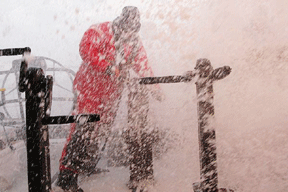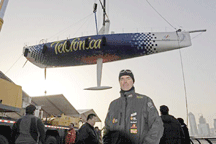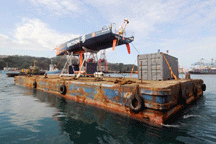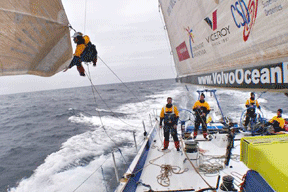
|
Volume XVII, Issue 10 - March 5 - March 11, 2009
|
|
Columns Reviews |
Five Boats Race 13,000 Miles
|
|
The Volvo Ocean Race, Leg 5: Underway
by Steve Carr
The Volvo Ocean Race has become a war of attrition.
Three of the boats that started the race in Spain decided to bag Leg Five, from China to Brazil. After sustaining crippling structural damage on the beater to China, Delta Lloyd and Telfonica Black are being shipped to Rio — where they can be rebuilt before leg six. Team Russia bowed out when corporate money dried up.
Then there were five.
Well, sort of.
|
|
|
|
![]() Ericsson 3 also blew apart on its way to China and limped into Keelung, Taiwan, to be hoisted onto a barge and shipped down the coast to Hualien. After a new bow was installed, the Ericsson crew returned to sea to resume their race to China to snag their hard-earned four points for Leg Four.They arrived in Qingdao in freezing darkness long after the rest of the fleet had left for Rio. After quickly greeting friends and family, they loaded their boat for the next torturous leg. Off they went, trailing the lead boat, Ericsson 4, by more than seven hours, but feeling like champions.
Ericsson 3 also blew apart on its way to China and limped into Keelung, Taiwan, to be hoisted onto a barge and shipped down the coast to Hualien. After a new bow was installed, the Ericsson crew returned to sea to resume their race to China to snag their hard-earned four points for Leg Four.They arrived in Qingdao in freezing darkness long after the rest of the fleet had left for Rio. After quickly greeting friends and family, they loaded their boat for the next torturous leg. Off they went, trailing the lead boat, Ericsson 4, by more than seven hours, but feeling like champions.
For second-place Telefonica Blue, China was a different story. After closing to within 3.5 points of the lead, Blue suffered a disappointing loss to Ericsson 4 in the in-port race around Qingdao Harbor. The next day, Skipper Bouwe Bekking announced that the Spaniards would take a three-point penalty in order to install larger rudders for the reaching and downwind conditions expected. Then disaster struck. Blue hit an uncharted rock on the way to the start. The team returned to shore, hauled the boat out of the water and repaired the keel overnight before finally launching 19 hours later.
Provisioning for 13k Miles
How can each boat carry enough gear for a 13,000-mile sailboat race?
Here’s how Telefonica Blue provisioned. Anticipating 35 to 40 days, they packed 17 food bags, each weighing 65 pounds and holding gear for two days. The meals are planned to give each sailor 5,000 calories per day.
• 700 power shakes
• 700 power bars
• 374 pounds of freeze-dried food (12 flavors)
• 270 sticks of gum
• 187 chocolate bars
• 68 packs of oatmeal
• 23 pounds hot chocolate
• 23 pounds dry milk
• 28 pounds dry nuts
• 20 pounds dry fruit,
• 11 bottles ketchup
• 10 boxes sweetener
• 9 bottles Tabasco sauce,
• 9 bottles sweet chili sauce
• 9 boxes of Earl Grey tea
• 8 pounds Nescafe Gold coffee
• 6 jars chocolate spread
• 4 boxes of salt and pepper
As well as edibles, they carry 68 rolls of toilet paper, 51 gas bottles, 34 rolls of paper towels, 11 packages of wet wipes, eight tubs of Vaseline, six scouring pads, six bars of soap, six bottles of soap spray and four bottles of talcum powder.
First Water Torture, then the Doldrums
Laden with supplies for a month-long race, the fleet sailed south to get clear of Japan, then hopped a ride on the Kuroshio Current, or Black Tide, a warm-water conveyor belt that pushed them northeast.
Within a few days, the crew aboard Ericsson 3 were the comeback kids, back in the race, overtaking Green Dragon and Telefonica Blue, closing to within eight hours of the pack.
|
|
![]() Unlike some of the previous legs where the boats were sailing upwind and constantly changing sails as they tacked, this was a Groundhog Day reachathon. The boats kept sailing east on port tack into a steady 15-knot northeasterly breeze in moderate 10-foot seas, with fire-hose waves breaking over the bow like the Chinese water torture.
Unlike some of the previous legs where the boats were sailing upwind and constantly changing sails as they tacked, this was a Groundhog Day reachathon. The boats kept sailing east on port tack into a steady 15-knot northeasterly breeze in moderate 10-foot seas, with fire-hose waves breaking over the bow like the Chinese water torture.
“For the four hours on deck it’s a constant drenching for the guys on watch,” reported Rick Deppe on Puma. “It’s not those knock-you-off-your-feet type waves that we saw the first two days out of Qingdao, rather more the slap-you-in-the-face-when-you’re-not-looking type. And down below it’s hot, humid and very smelly. Six days worth of wet foot traffic is starting to take its toll on the ambience.”
Aboard the lead boat Ericsson 4, the monotonous grind took on a humorous note as reported by Guy Salter: “Tony [Mutter] surprised all today by coming on watch as if he were ready for the final scenes of … Phantom of the Opera as the lead role. He had the left side of his face covered in his Phantom mask — only this was from baby anti-rash cream, due to the prolonged port tack we have been on and the constant saltwater spray is playing havoc with his skin.”
After five 400-mile days, the leaders, Ericsson 4 and Puma, smashed the 10,000-mile barrier, with the key question still looming menacingly over each nav station: to keep heading east or to plunge south. Because dead ahead lay the dreaded Doldrums, a swirling band of light air moving unsteadily across the equator. Each boat would have to pick its line through this dead zone long before getting there — long before the weather forecasts could guide their choice.
Tune in next month to find out who guessed right and was first to catch the southeast trade winds home to Rio.



